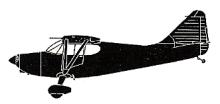
ASN Wikibase Occurrence # 156228
This information is added by users of ASN. Neither ASN nor the Flight Safety Foundation are responsible for the completeness or correctness of this information.
If you feel this information is incomplete or incorrect, you can submit corrected information.
| Date: | Tuesday 4 June 2013 |
| Time: | 17:00 |
| Type: |  Stinson 108 |
| Owner/operator: | Club Voyager LLC |
| Registration: | N97592 |
| MSN: | 108-592 |
| Total airframe hrs: | 2723 hours |
| Engine model: | Franklin 6A4-150-B3 |
| Fatalities: | Fatalities: 0 / Occupants: 2 |
| Aircraft damage: | Substantial |
| Category: | Accident |
| Location: | Near Standard Field Airport - 5KY4, Elkton, KY -
 United States of America United States of America
|
| Phase: | Initial climb |
| Nature: | Private |
| Departure airport: | Elkton, KY (5KY4) |
| Russellville, KY (4M7) | |
| Investigating agency: | NTSB |
| Confidence Rating: |
Following an uneventful full-stop landing, taxi back, and takeoff, the pilot continued around the airport traffic pattern and approached the runway for a second time, intending to perform a touch-and-go landing. The airplane subsequently touched down about one-third down the length of the runway. The pilot then increased engine power to full, and the airplane began to climb. As the airplane climbed, the pilot noted that the climb rate seemed to be slower than it was previously even though the engine appeared to be operating normally. The pilot continued the takeoff, but he then realized that the airplane would not be able to clear the trees, so he decided to land the airplane in a nearby field. During the landing, the airplane nosed over, resulting in substantial damage to the airframe. A postaccident examination of the engine revealed no evidence of mechanical malfunctions or failures that would have precluded normal operation.
The atmospheric conditions at the time of the accident were conducive to serious carburetor icing at glide power settings. The pilot did not recall using carburetor heat during the approach to landing, and a postaccident examination of the airplane revealed that the carburetor heat control was in the "off" position. Therefore, it is likely that the airplane's carburetor accumulated ice during the approach to landing, which resulted in the observed partial loss of engine power during the subsequent climb. The application of carburetor heat during the approach could have prevented any initial accumulation of carburetor ice, and application subsequent to that point may have melted any previously accumulated ice and restored engine power.
Probable Cause: The pilot's failure to use carburetor heat during the approach to landing, which resulted in carburetor icing and a partial loss of engine power during a subsequent initial climb.
Accident investigation:
 |
|
Sources:
NTSB
FAA register: http://registry.faa.gov/aircraftinquiry/NNum_Results.aspx?NNumbertxt=N97592
Location
Revision history:
| Date/time | Contributor | Updates |
|---|---|---|
| 04-Jun-2013 23:31 | Geno | Added |
| 05-Jun-2013 03:06 | Geno | Updated [Time, Aircraft type, Registration, Cn, Operator, Source, Narrative] |
| 21-Dec-2016 19:28 | ASN Update Bot | Updated [Time, Damage, Category, Investigating agency] |
| 29-Nov-2017 08:47 | ASN Update Bot | Updated [Other fatalities, Nature, Departure airport, Destination airport, Source, Narrative] |
Corrections or additions? ... Edit this accident description
The Aviation Safety Network is an exclusive service provided by:


 ©2024 Flight Safety Foundation
©2024 Flight Safety Foundation